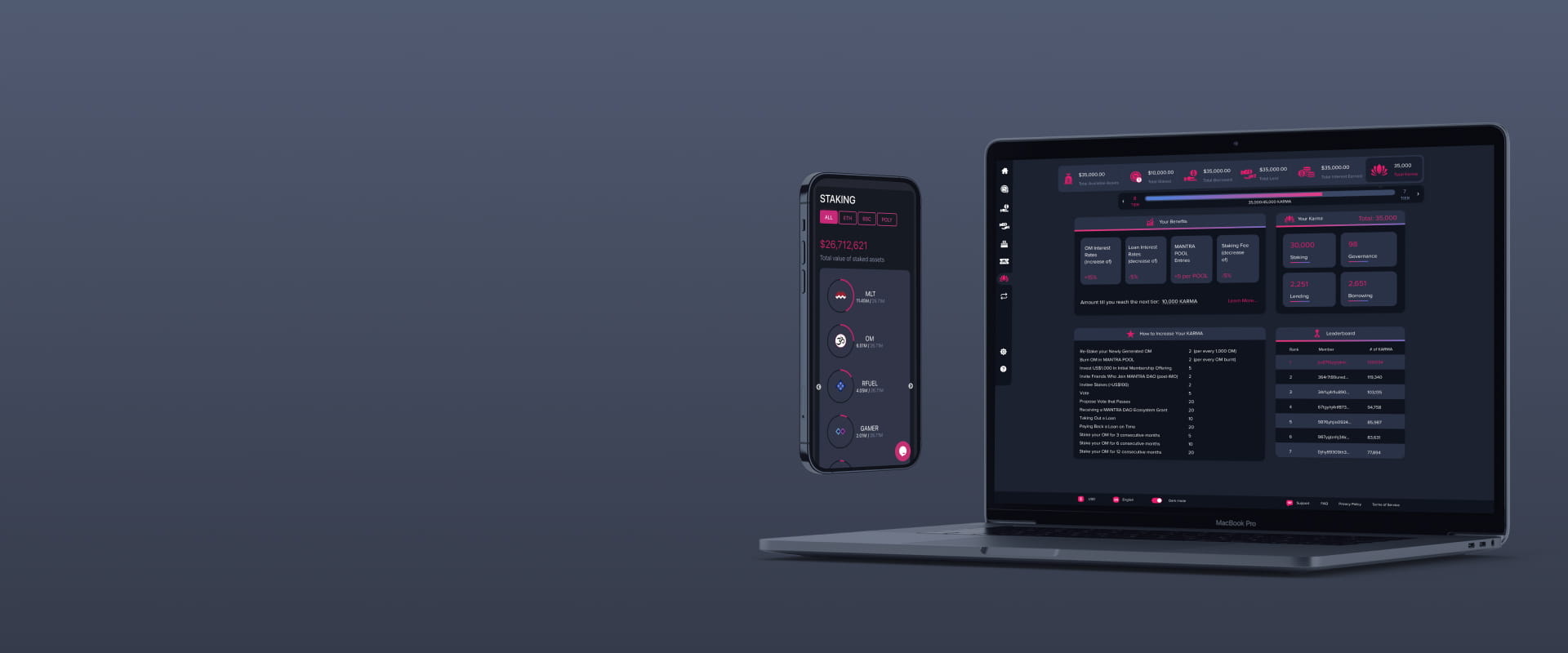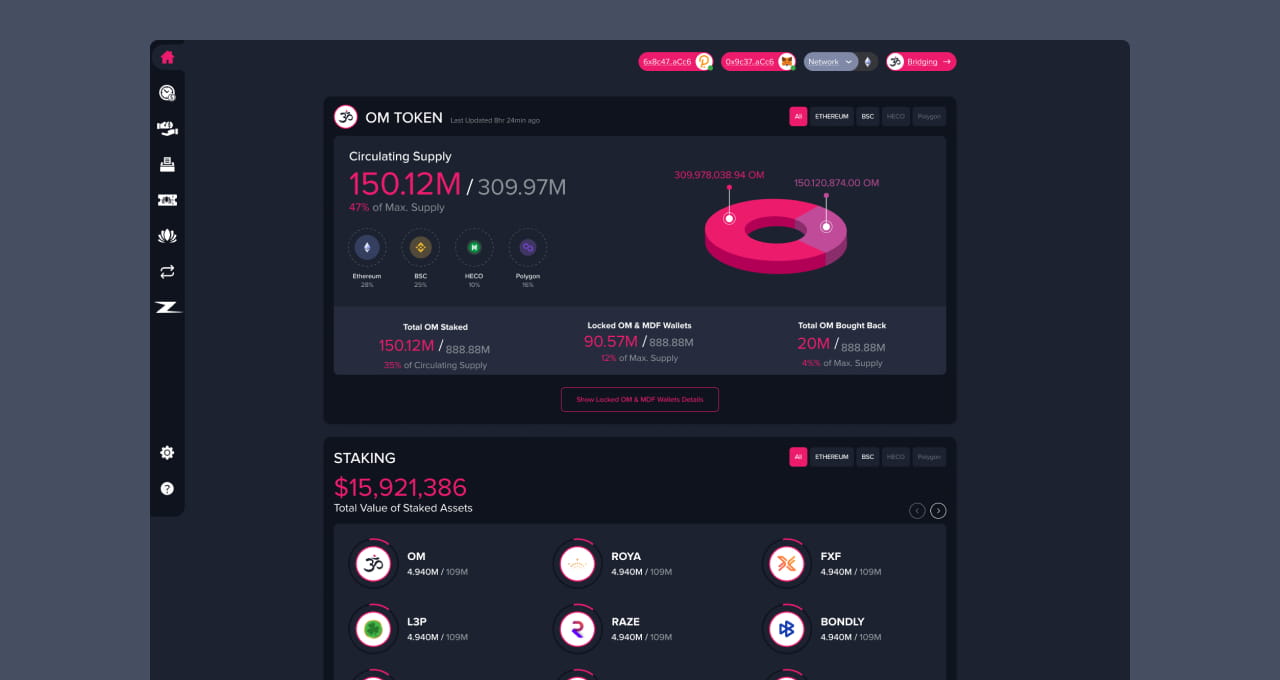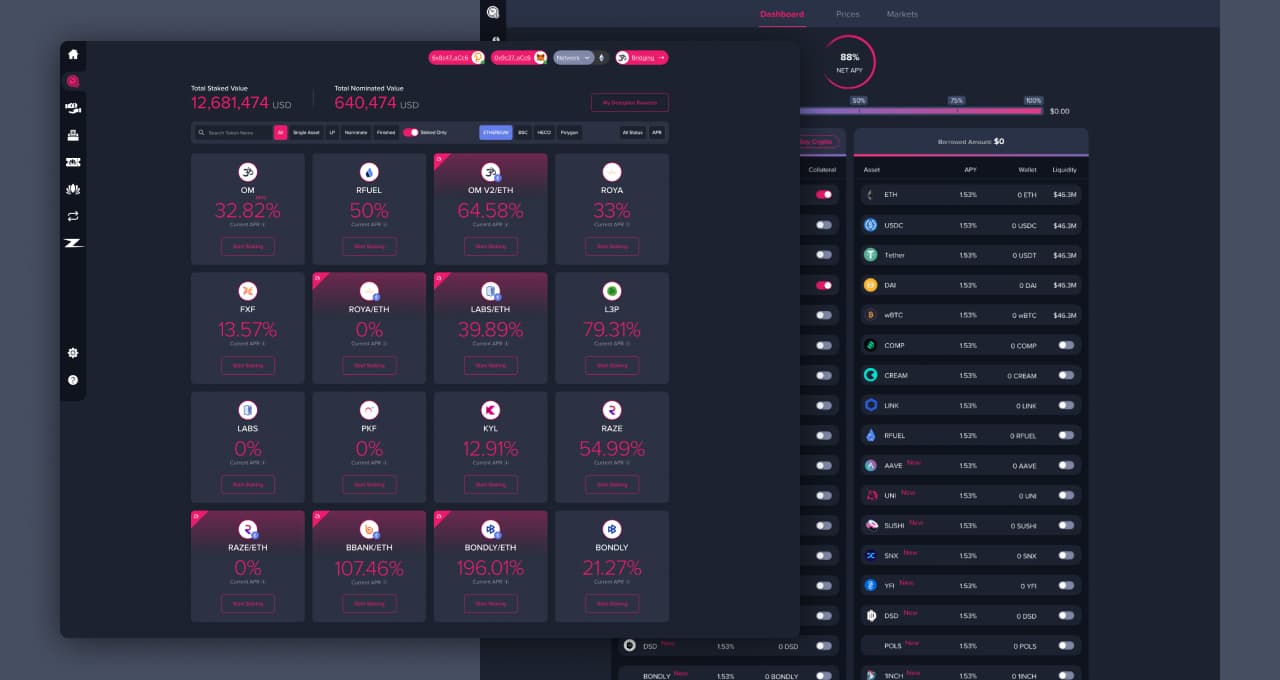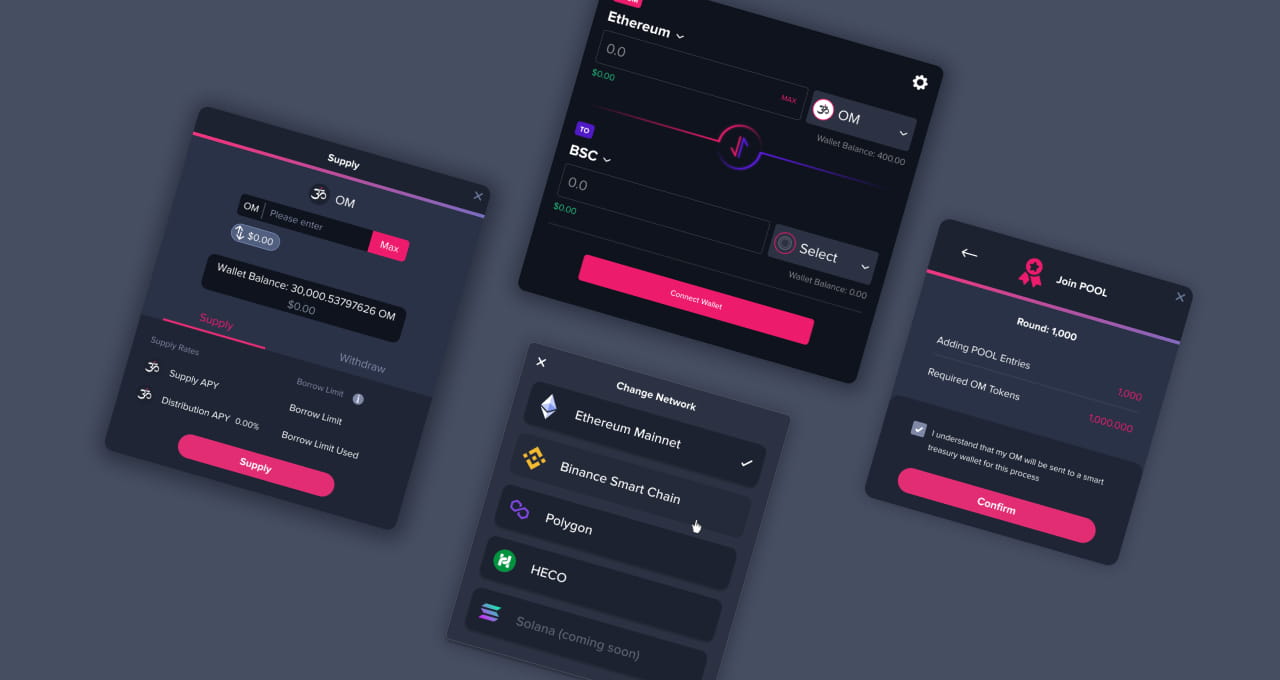
- Home
- Success stories
- Mantra DAO
About the client
Our client, Mantra DAO, is developing a community-governed DeFi platform aimed at giving financial control back to users through a transparent and decentralized ecosystem. The platform is focused on lending, staking, governance, and launchpad services.Details
- Website:app.mantradao.com
- Location:Hong Kong
- Date:2021
Business opportunity
Initially, the client brought in a third-party service provider to assist them with the development of their DeFi platform. However, the resulting platform had inefficiencies such as bugs in existing smart contracts that needed to be fixed.
Aiming to continually improve the platform, the client wanted to enhance it with new functionality by implementing new smart contracts and adding new platforms, including Binance Smart Chain and Polygon (being built as a Polkadot-first project, the platform only supported Ethereum when the customer approached PixelPlex). These changes would allow Mantra DAO to offer services on different blockchains.
The client chose PixelPlex to complement their in-house team and join their project as a trustworthy technology services provider with extensive experience in blockchain and smart contracts development.
Project goals
Together with the client, we established the key project goals:
- 1
Improve the performance of the Mantra DAO platform and eliminate inefficiencies
- 2
Add new smart contracts and staking pools
- 3
Incorporate multi-chain support
- 4
Add new functionality to the existing platform
Work done
Development of smart contracts
Deployment of new staking pools
Migration from staking pool V1 to staking pool V2
Extension of the existing functionality to new platforms (Binance Smart Chain, Polygon)
Bug fixes, UI enhancements, and inefficiencies resolution
Project features
Multi-chain support, including Ethereum, Binance Smart Chain and Polygon
Multiple staking pools on different networks
The ability to manage assets staking and governance in one place
The platform’s own token – OM token
Secure smart contracts for staking pools
Zendit launchpad solution offering all the necessary tools and resources for organizations to launch their tokens
Details
* The design of layouts was provided by the client.
One of the largest of Mantra DAO’s modules is Staking, which allows users to stake tokens and receive token rewards. The company offers both single asset and LP staking pools. The client had already developed staking smart contracts when we joined the project, but they had bugs that could lead to potential security issues in the production environment.
To prevent security problems, our team resolved the bugs in the LP staking smart contract and followed up with unit tests. We also developed a smart contract for single asset staking from scratch. The logic we introduced makes it easy to roll out new staking pools.
Staking pools deployment
Mantra DAO regularly partners with different organizations and adds further new tokens to staking pools. For each partnership our specialists deploy new staking pools based on the parameters provided by the customer (for example, token owner or token rewards).
To begin with, our team implemented new staking pools on the Ethereum network. In order to offer a chain-agnostic solution, the client extended their staking to Binance Smart Chain and Polygon, so our team is now also responsible for deploying new staking pools for these platforms.
Throughout the project we deployed 60+ staking pools on different networks (Ethereum, Binance Smart Chain, Polygon).
Security audit
Focusing on enhanced security, the customer approached SlowMist – a company engaged in blockchain ecological security – to perform security audits of smart contracts developed by our team. After a detailed analysis and testing, our smart contracts successfully passed the audit with no major issues found.
PixelPlex assisted the client with the development of Zendit launchpad. It uses a decentralized fixed swapping protocol which provides transparency with regard to the number of tokens offered during a token launch. Zendit offers the client’s partner organizations the necessary resources and support to launch their tokens.
Dutch Auction mechanism
The distinctive feature of the implemented launchpad is that it offers the opportunity to use a Dutch Auction style of launch in addition to standard fixed swap protocols. The major benefit of the Dutch Auction mechanism lies in it being a decentralized and democratic way of determining the price of a company’s coin, where bidding for an item begins with a high asking amount which is systematically lowered until a user makes the winning bid and the item is sold.
PixelPlex assisted the client in implementing the logic for migration from staking pool V1 to staking pool V2 and token swap to OM V2.
OM V2 is an enhanced version of the OM token, which has many important advantages, including but not limited to:
- auto-compounded staking rewards
- immediate unstaking for a fee
- the ability to cancel unstaking and automatically re-stake
- improved countdown timer (seconds, minutes, hours, days).
Thanks to the implemented logic, Mantra DAO end users can migrate to a new version in only a few clicks and start staking OM V2 tokens.
Development of a migration mechanism
The major problem was that the first version of the staking pool developed by the client didn’t have migration functionality. It was essential that users’ existing assets could be seamlessly migrated to staking pool V2 so that users who had tokens in staking pool V1 could easily receive rewards in the new staking pool.
Our team conducted technical research to make the required migration possible. We made changes to the existing architecture of the solution and implemented a migration mechanism. As a result, the platform’s users were able to easily move to staking pool V2 without losing their existing tokens and rewards.
Got an idea? Let’s work together
Moving from Ethereum to Solana
Benefits of using Solana
The use of PoS consensus algorithm
Frequent transactions (more than 65,000 per second)
Better scalability
Lower transaction cost ($0,00025)
Prepared research
Our blockchain consultants prepared research, which covered multiple aspects and the various peculiarities of the Solana blockchain. It included details such as a high-level overview of the platform, the ownership of accounts, a guide on how to create a coin in Solana, and returning values from cross-program invocations.
When the final decision to move to Solana was made, the client asked our team to choose the optimal migration strategy and then proceed with the chosen variant. PixelPlex tech specialists researched different migration options, evaluating the pros and cons of each scenario.
Choosing the best migration strategy
1st strategy
Use Neon virtual machine to run Solidity contracts directly in Solana
- Dependency on the Neon project
- This approach offers less flexibility due to the dependency on a third-party tool
- A simple solution as it may not require writing any code
- Neon is very immature, which results in bugs and limitations (e.g. we faced many issues trying to deploy a simple Ethereum contract)
- It is a whole new ecosystem with its own coins (which are now sold to private investors)
- It can only be used for Solana
2nd strategy
Rewrite everything in Rust
- There is no dependency on any project
- Better overall flexibility
- It will take more time compared to using a virtual machine, yet the performance can be tuned to fit the client’s need
- The maintenance burden
3rd strategy
Compile Solidity contracts into Solana’s blockchain using Solang
- Compile Solidity contracts into Solana’s blockchain using Solang
- Better flexibility as some of the contracts may be rewritten completely while others will be recompiled by Solidity compiler
- A simple solution as there is no need to completely rewrite all the contracts
- Solidity contracts must be tuned to circumvent restrictions of Solang
- Assembly language can't be compiled (but it is used in the MANTRA Dao stake contracts)
- Sizes of integers must not be higher than 64 bit (whereas they are bigger in the project)
- Need to write code in order to trigger these smart contracts, which will add to the maintenance burden
Initially, we considered taking advantage of the Solang compiler due to its flexibility and time-efficiency. However, after reviewing the limitations associated with Solang, we decided to go with rewriting everything in Rust. This approach allowed us to achieve increased flexibility and performance. Currently our team is in the process of migrating to the Solana blockchain.
Results
60+
staking pools deployed
$23M
total value of stacked assets (as of April 2022)
Services
We offer a comprehensive range of services, including IT consulting, custom software development, and specialized expertise in blockchain, machine learning, and data science.
Blockchain Development
Blockchain Development
Smart Contract Development
Web3 Development
Crypto Payment Solutions
Tokenization Services
Protocols
Protocols
Cryptocurrency Exchange Development
Cryptocurrency Development
Top Development Company
Blockchain Consulting
Top Blockchain Consulting Company
Custom Software Development
Mobile App Development
Web Development
Top IT Services Company
IT Consulting
Top Consulting Company
ML Development
Artificial Intelligence Development
Machine Learning Development
Data Science Development
Top BI & Big Data Company
AR & VR Development
AR & VR Development
QA & Software TestingQA & Software Testing Services
UI/UX DesignGive us the pleasure of adding our secret sauce to your app.
We’ll create beautiful screens at the front while breaking the limits of what’s behind them to help your app get to beyond-plausible business achievements.
UI/UX Design Services
MVP DevelopmentValidate your product idea quickly with an MVP—launch faster, test smarter, and refine based on real user feedback.
Leverage our expertise in MVP development to build a scalable, market-ready product with minimal risk and maximum efficiency.
MVP Development Services
Metaverse Consulting & DevelopmentValidate your immersive concept quickly with metaverse development — launch your virtual experience, gather actionable user insights on core features like avatars and social interaction, and iterate based on real-world engagement.
Top Development Company
Solutions
RWA PlatformTokenization makes it easier to trade assets and opens up new investment opportunities and diversifies portfolio.
RWA Platform
Asset tokenization platform development
Arbitrage BotProfit from market inefficiencies with automated, customized trading strategies that boost returns and minimize risk.
Arbitrage Bot
Be a transaction ahead. Catch profit at short notice
CryptoAPIGain an unfair data edge for your dApps. Tap into high-quality blockchain insights to outsmart competitors and fuel smarter decisions.
CryptoAPI
Connect your dApps to blockchain networks in a flash
OTC HawkOffer high-net-worth clients a secure, enterprise-grade trading terminal. Streamline deals, enhance reliability, and optimize top-tier crypto assets.
OTC Hawk
Benefit from our portfolio and wealth management app
DocFlowManage sensitive documents on blockchain. Leverage optional zero-knowledge proofs for trust, privacy, and streamlined workflows.
DocFlow
Intuitive Blockchain-Powered Document Management System
Know-Your-TransactionEnsure every transaction is above board. Monitor digital asset flows for compliance and transparency, supporting both businesses and regulators.
KYT crypto platform
Our KYT platform fosters integrity of financial ecosystems
Industries
We work across a variety of industries, from FinTech to eCommerce, leveraging our accumulated knowledge and best practices to deliver solutions tailored to the unique needs of your business.
FinTech & BankingAs traditional finance goes digital, we are committed to building efficient ecosystems and better engagement.
Think of customized FinTech solutions with tamper-proof transactions and storage, progress transparency and automation — and we’ll make them see the light of day.
$25T
Global Financial Services
20%
Digital/Blockchain Growth
Solutions for FinTech & Banking
Retail & eCommerceWhether you market B2B or B2C, commerce tech trends are all about value-driven purposes, global sustainability, hybrid shopping journeys, and extra-resiliency.
Let your clients know that there’s more to your brand than meets the eye by creating unique customer experiences in all your stores.
$6.3T
Global eCommerce
10-15%
Tech Innovation Growth
Solutions for Retail & eCommerce
Supply Chain & LogisticsTo make things easier for all vendors, we deliver apps for route and cost optimization, vehicle operational support, and better dispatch time efficiency.
With focus is sustainability, resilience, transparency, and immutability, let’s get your transformation going.
$10T
Global Logistics
15-20%
Blockchain Adoption Growth
Solutions for Supply Chain & Logistics
HealthcareCustom healthcare software solutions are aimed at helping you ensure accurate diagnosis, better patient engagement, and positive healthcare outcomes.
Whether you require a patient management solution, practice management software, EMR/EHR system, or ML-enabled diagnostics – we’ve got you covered.
$10T
Global Healthcare
20%
Digital/Blockchain Growth
Solutions for Healthcare
Real EstateKeep up with digital innovation trends by accelerating enterprise transformation and scaling, leveraging data and orchestrating workflows.
Whether you manage and sell commercial facilities or invest third-party capital, our integrated solutions help you make the most of it.
$340T
Global Real Estate
15%
PropTech/Blockchain Growth
Solutions for Real Estate
Oil & GasWith mobility and digital technologies standing to change the game and define leadership, our mission is to get you digital-first.
Resolve operational and conceptual issues by introducing clear tech vision, feasible architectures, and flexible software to take business extension off limits.
$4T
Global Oil & Gas Industry
10-15%
Digital/Blockchain Growth
Solutions for Oil & Gas Industry
InsuranceImagine a world where quoting policies, processing claims, and managing mountains of paperwork are effortless. PixelPlex can help you achieve just that.
Break free from outdated systems and focus on what truly matters – delivering exceptional service to your policyholders and growing your insurance business.
$25T
Global financial services
20%
Digital/blockchain growth
Solutions for Insurance Industry
Success stories
Domain
Industry
Protocols
Company
About us Team Careers Social Responsibility ContactsBlog
Blockchain Big Data Artificial Intelligence AR/VR Mobile News View Blog


